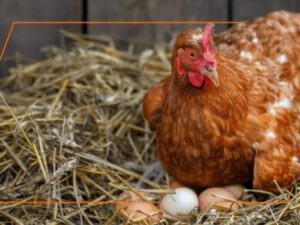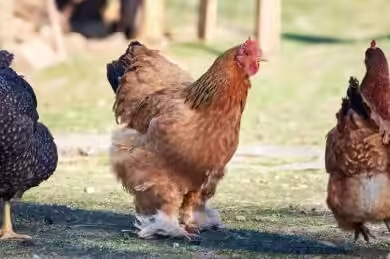Last updated on July 30, 2025
Dreaming of collecting your first delicious, fresh eggs right from your backyard? Knowing exactly how many months do layers start laying eggs is key to making that dream a reality! Typically, laying hens commence egg production between 4 to 6 months of age. This timeframe is super important for managing your flock, getting your nesting boxes ready, and anticipating that exciting moment when you find that first egg. It helps you plan everything as your pullets (that’s what we call young hens before they start laying) grow up!
How Many Months Do Layers Start Laying Eggs? The Typical Timeline
Most pullets reach sexual maturity and start laying eggs somewhere between 4 to 6 months old. This is often referred to as the age chickens start laying eggs. It’s when their bodies are ready for the amazing work of producing eggs.
But why the range? Great question! Several factors play a big role here. Things like the chicken’s breed, the quality of their diet, how much light they’re getting, and even how stressed they are can all affect when they start laying. A happy, healthy, well-fed pullet with enough daylight usually starts right on schedule, maybe even a little early! On the flip side, poor nutrition or stressful conditions can definitely delay things.
How Many Months Do Layers Start Laying Eggs in Nigeria? Local Insights
In Nigeria, like in many places with favorable climates, layers typically start laying eggs between 4 to 6 months old. Our climate, especially the amount of natural daylight we get year-round, can be quite favorable for egg production.
However, management practices are key here. Access to quality feed formulated for layers is crucial. Clean water, good housing that protects them from extreme weather (yes, even heat!), and proper health management make a huge difference.
Common breeds here, like the Isa Brown or Black Australorp crosses, often start laying right within that 4-6 month window if they’re well cared for. Sometimes, with excellent management and genetics, you might even see eggs closer to 4 months! It really highlights how much the environment and care influence the egg production timeline.
When Do Chickens Start Laying Eggs by Breed? It Depends!
The age chickens start laying varies significantly by breed. Some breeds are like eager beavers, ready to start producing eggs relatively early, while others take their sweet time.
Here’s a quick look at some common breeds and their typical start-laying ages:
| Breed | Typical Start Laying Age (Months) |
| Leghorn | 4-5 |
| ISA Brown / Sex Links | 4-5 |
| Rhode Island Red | 5-6 |
| Plymouth Rock | 6 |
| Australorp | 5-6 |
| Orpington | 6-8 |
| Cochin | 7-9 |
| Brahma | 7-9 |
| Easter Egger | 6 |
| Silkie | 8-9 |
- Early Layers: Breeds known for high egg production, like Leghorns or popular Sex Links (Isa Brown, Rhode Island Red crosses), tend to start laying closer to the 4 or 5-month mark. They’re bred for efficiency!
- Later Layers: Heavier breeds or those primarily raised for meat, as well as some heritage breeds (Brahmas, Cochins, Orpingtons), often won’t start laying until they are 6, 7, or even 8 months old. They mature more slowly.
So, the breed of your laying hens age is a major predictor!
How Do I Know My Chickens Are Ready to Lay Eggs? Spotting the Signs
You can know your chickens are ready to lay eggs by observing specific physical changes and behavioral indicators. Waiting is hard, I know! But your pullets will give you clues when they’re getting close to laying their first egg. Look for these tell-tale signs!
Physical Changes:
- Their combs and wattles will start to grow larger, turn a brighter red, and feel warmer. This indicates hormonal changes!
- Their pelvic bones, located just below their vent, will start to widen and become more flexible. You can gently feel this.
Behavioral Indicators:
- They might become more interested in nesting boxes, hopping in and out or rearranging bedding.
- Some might do a little squatting motion when you go to pet them (pinning), indicating they’re physically mature and ready.
- They might start eating a bit more, gearing up for the energy needed for egg production.
These signs usually pop up a couple of weeks before that first egg appears!
Egg Production Expectations: How Many Eggs Can You Really Get?
Alright, the big question once they start laying is, how many eggs can you actually expect? You’re probably wondering, how many eggs does a hen lay per day? For most hens, the answer is usually one. They typically lay one egg every 24 to 26 hours, not one every single day without fail. Some super producers might manage closer to daily, but it’s not the norm for every hen.
So, if it’s one egg every day or so, how many eggs does a hen lay in a month? You can do the math – it’s roughly 20-30 eggs a month, depending on the hen and the time of year. Over a whole year, how many eggs does a hen lay in a year naturally? A really good layer, especially during her peak, can give you anywhere from 200 to 300+ eggs annually. This is for commercial breeds under optimal conditions. Backyard hens might lay a bit less, maybe 150-250, depending on breed, age, and care. It’s still a fantastic yield!
Factors Affecting Egg Production: Keeping Those Eggs Coming
Getting eggs isn’t just about waiting for the right laying hens age. Once they start, you need to keep them happy and healthy to maintain good production! Several things can really impact how many eggs you get:
| Factor | Impact on Laying |
| Nutrition | Affects egg quantity & shell quality |
| Lighting | Needed for consistent laying (14-16 hrs) |
| Health/Stress | Can cause laying to stop completely |
- Nutrition and Feed Quality: They need a balanced layer feed with enough protein and calcium for strong eggshells. Poor diet means fewer eggs or weak shells.
- Lighting and Daylight Hours: Chickens need about 14-16 hours of light per day to lay consistently. Natural daylight is great, but supplemental lighting can help keep production up in shorter months. The amount of light directly affects their reproductive cycle. For more detailed information on lighting and other factors, check out resources like this guide from the University of Minnesota Extension.
- Health and Stress Levels: Sick chickens won’t lay. Parasites, diseases, or stress from predators, changes, or overcrowding can put a halt to egg-laying. A calm, safe, and healthy environment is key for a consistent egg production timeline!
When Do Chickens Lay Eggs: Day or Night? Understanding the Cycle
Chickens lay eggs almost exclusively during the day, typically a few hours after sunrise. This is pretty cool! Their laying cycle is tied to light. The process of forming an egg takes about 24-26 hours. Ovulation usually happens in the morning, and then the egg travels through the reproductive tract, getting its shell added along the way.
So, if you’re looking to collect fresh eggs, the best time is usually late morning or early afternoon. You won’t find them popping out eggs in the dark!
How Many Months Does It Take Old Layers to Start Laying Eggs Again? The Molting Pause
After molting, old layers typically take anywhere from 1 to 4 months to start laying eggs again. Molting is a natural process, usually happening once a year, often in the cooler months when daylight decreases, where they lose their old feathers and grow new ones.
During molting, egg production usually stops completely. Their bodies are putting all their energy into growing those new feathers. It’s like a necessary break. Providing good nutrition during this time helps them recover faster and get back to their chicken laying behavior.
At What Age Do Chickens Stop Laying Eggs? The Golden Years
Consistent, high-volume egg laying in chickens typically stops around age 5 or 6 years. It’s a sad thought, but chickens don’t lay forever, and their egg production naturally declines as they get older. Most hens are in their prime laying years during their first two years of life. After that, production starts to slow down gradually.
By the time they are 3 or 4 years old, they might only be laying a few eggs a week, or even less. Some hens might continue to lay sporadically for several more years, but the consistent, high-volume laying usually stops around age 5 or 6. It really depends on the breed and the individual hen. It’s part of the natural egg production decline.
What Is the Best Age for Chickens to Lay Eggs? Hitting Their Stride
If you’re aiming for maximum egg production, you might ask, what is the best age for chickens to lay eggs? Hands down, it’s their first year of laying. This usually starts around 5-6 months old and continues for the next 12-18 months. This is when they are young, vigorous, and haven’t gone through their first big molt yet.
During this peak period, they lay the most eggs, and often the eggs are a good size. Their second year is still quite productive, but you might notice a slight dip compared to the first. Balancing longevity with productivity means enjoying that peak but also appreciating the eggs you get from older, beloved hens!
Can Chickens Lay Eggs at 4 Months? The Early Birds
Okay, so we said 4-6 months is typical, but can chickens lay eggs at 4 months? Absolutely! Some breeds, especially those early-laying ones we talked about like Leghorns and Sex Links, can definitely start laying when they are just 4 months old. It’s less common for heavier breeds, but it happens.
If your pullets start laying this early, that’s generally a good sign! It means they’ve developed well and are healthy. However, the first eggs might be smaller than average. That’s totally normal! They call these “pullet eggs.” The size will increase as the hen matures over the next few weeks. Just make sure they are on a good layer feed to support this early production.
Frequently Asked Questions About Chicken Laying
Got more questions buzzing in your head? Here are a few quick answers to some common queries:
What is a pullet egg?
A pullet egg is simply one of the first eggs laid by a young hen (pullet). They are typically smaller than eggs from mature hens, but they are perfectly fine to eat!
How long does a chicken live?
While commercial layers are often replaced after 1-2 years for peak production, backyard chickens can live much longer, often 6-8 years or even more with good care.
Do chickens lay eggs in the winter?
Egg production often decreases or stops in winter due to fewer daylight hours. Providing supplemental light can help maintain laying through the colder months.
Why did my chicken suddenly stop laying?
This could be due to several factors, including molting, stress, poor nutrition, lack of light, or illness. Checking for signs of molt, ensuring they have enough light and good feed, and observing their behavior can help you figure out why.
Conclusion: Optimizing Egg Production in Your Flock
Whew, we’ve covered a lot, haven’t we? Understanding when do chickens start laying eggs is just the beginning of a rewarding journey. We know that most layers start between 4 and 6 months, with breed and care playing big roles, and that includes how many months do layers start laying eggs in Nigeria.
We’ve seen the signs that tell you they’re ready and talked about how many eggs you might get – remember, it’s usually one a day or so, adding up to potentially hundreds a year! We also touched on the factors that keep those eggs coming (feed, light, health) and the natural pauses like molting and the eventual at what age do chickens stop laying eggs.
To really get the most from your flock, focus on providing excellent nutrition, enough light, a stress-free environment, and proactive health care. Knowing your breed helps set realistic expectations for their egg production timeline. It’s all about giving your girls the best life so they can give you those beautiful, fresh eggs!
Want to become a chicken-raising pro? Explore our other guides on chicken care to learn more about specific chicken breeds or common health issues affecting layers! Or, if you have questions about your flock, share them in the comments below – I’d love to hear from you!


